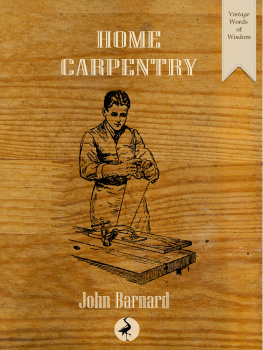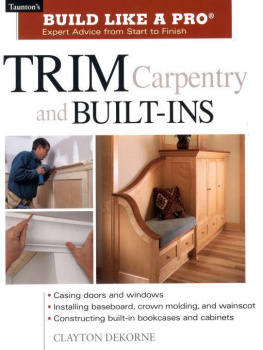
BLACK&DECKER
The Complete Guide
CARPENTRY FOR HOMEOWNERS
Basic Carpentry Skills & Everyday Home Repairs

CHANHASSEN, MINNESOTA
www.creativepub.com

Copyright 2008
Creative Publishing international, Inc.
18705 Lake Drive East
Chanhassen, Minnesota 55317
1-800-328-3895
www.creativepub.com
All rights reserved
Printed in China
10 9 8 7 6 5 4 3 2 1
Library of Congress Cataloging-in-Publication Data
Marshall, Chris,
The complete guide to carpentry for homeowners: basic carpentry skills &
everyday home repairs / by Chris Marshall.
p. cm.
At head of title: Branded by Blacks & Decker.
Summary: Shows readers how to solve everyday problems using the most
basic of toolshammers, saws, sanders, clamps, and screw guns
Provided by publisher.
Includes index.
ISBN-13: 978-1-58923-331-7 (soft cover)
ISBN-10: 1-58923-331-X (soft cover)
1. CarpentryAmateurs manuals. 2. DwellingsMaintenance and repair
Amateurs manuals. I. Title. II. Title: Carpentry for homeowners.
TH5607.M37 2008
694.6dc22
2007024074
President/CEO: Ken Fund
Vice President for Sales & Marketing: Peter Ackroyd
Home Improvement Group
Publisher. Bryan Trandem
Managing Editor: Tracy Stanley
Senior Editor: Mark Johanson
Editor: Jennifer Gehlhar
Creative Director: Michele Lanci-Altomare
Senior Design Manager: Brad Springer
Design Managers: Jon Simpson, Mary Rohl
Director of Photography: Tim Himsel
Lead Photographer: Steve Galvin
Photo Coordinator: Joanne Wawra
Shop Manager: Bryan McLain
Production Managers: Linda Halls, Laura Hokkanen, Stasia Dorn
Page Layout Artist: Danielle Smith
Photographers: Andrea Rugg, Joel Schnell
Shop Help: Dan Anderson, Tami Helmer, John Webb
The Complete Guide to Carpentry for Homeowners
Created by: The Editors of Creative Publishing international, Inc., in cooperation with Black & Decker.
Black & Decker is a trademark of The Black & Decker Corporation and is used under license.
NOTICE TO READERS
For safety, use caution, care, and good judgment when following the procedures described in this book. The publisher and Black & Decker cannot assume responsibility for any damage to property or injury to persons as a result of misuse of the information provided.
The techniques shown in this book are general techniques for various applications. In some instances, additional techniques not shown in this book may be required. Always follow manufacturers instructions included with products, since deviating from the directions may void warranties. The projects in this book vary widely as to skill levels required: some may not be appropriate for all do-it-yourselfers, and some may require professional help.
Consult your local building department for information on building permits, codes, and other laws as they apply to your project.
Contents
The Complete Guide to Carpentry for Homeowners


Introduction
Unless you live in a brand-new home thats built exactly to your specifications, you probably consider your house to be a perpetual work-in-progress. Most homeowners feel this way. It could be that the previous owner didnt quite take regular repairs and maintenance as seriously as you do. You know those irritating blemishes: the scuffed door molding in the entryway, a ding in the wallboard from a wayward rocker, or the closet door that rubs the carpet and sticks in its opening every time you close it. Youd love to fix them, if only you knew exactly what to do. Or, maybe your home is still stuck in a bygone decade and needs a serious facelift. Those dark, chintzy hollow-core doors really have to go someday, right?
More than likely, you also have projects that get perpetually pushed deeper down the to do list because they just seem too daunting to start. Oh, how nice it would be to replace the drafty family room windows with a large bay window. Do you dream of a cozy casual space or home theater room in the basement, if only you had the skills to frame the walls and finish it all off without hiring it done?
This new book, The Complete Guide to Carpentry for Homeowners, is not written for the do-it-yourselfer who already has a truckload of tools and years of experience. Instead, its written for the homeowner who simply needs the confidence and know-how to do the job right.
Weve prepared this book in three major sections to make navigating the material as easy as possible. The first section on tools and materials will give you a shop-class crash course. Youll learn about essential carpentry tools and how to use them correctly and safely.
The second section focuses on basic carpentry skills and projects. Here youll learn how your house is fundamentally put together so you can remove and build walls, frame and hang interior doors, install wallboard and finish up with trim and moldings. You could probably check off many of the gotta do projects on your list with this section alone.
The third partan advanced projects sectionwill earn you your black belt in home carpentry. Youll discover how to enlarge window and door openings, learn how to install windows, exterior doors, and skylights, and flash them properly, just like the pros do. Finally, an extended section will show you how to remove and replace kitchen cabinets, install ready-made countertops, and even build your own custom version from scratch. Heres how you can create the room youve always wanted without hiring an expensive crew to do it.
So, read carefully and then start planning your first carpentry project. Its easier than you think. Be sure to keep this book handy. With this much helpful information, youll come back to it again and again.

Planning a Carpentry Project
A carpentry project can be fun and rewarding, but it requires more than just a knack for cutting lumber and pounding nails. In fact, your natural ability with tools may not affect the finished product as much as your attention to details, materials, costs, and local building codes. Address these issues in the planning stages so you can use your time efficiently once you start to cut. Start any project by asking yourself the questions below. Once youve addressed each question, you can feel confident about the project youre about to start.
Is a permit required? Most building departments require a permit if your carpentry project will significantly alter your homes condition. Youll probably need a permit for anything more extensive than replacing a rotted window. Permits are required for adding or replacing beams, posts, joists, rafters; for building additions; for converting a basement or attic; and for many other projects. Ask your building department for any literature on carpentry projects. If a permit is required, youll need to show an inspector a detailed diagram and a list of building materials before you begin.








 BLACK&DECKER
BLACK&DECKER


 Planning a Carpentry Project
Planning a Carpentry Project